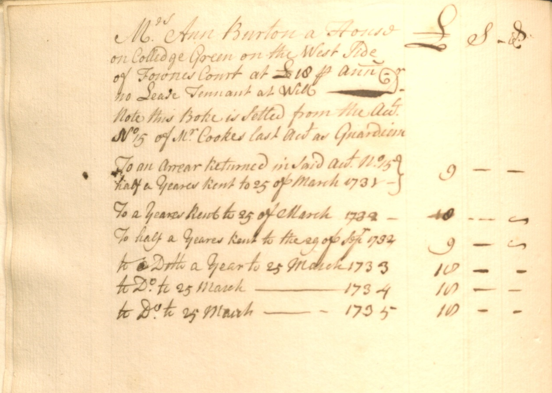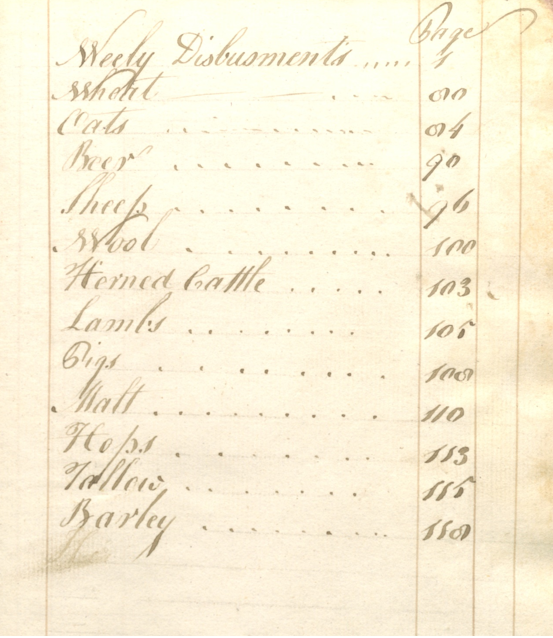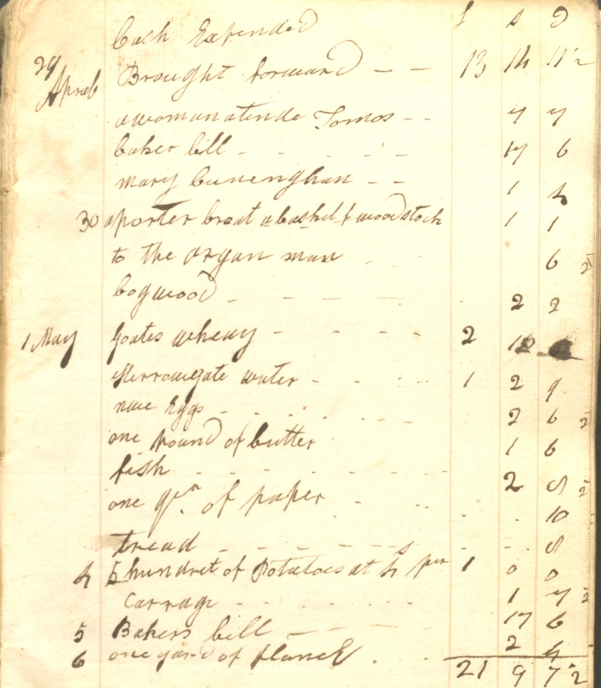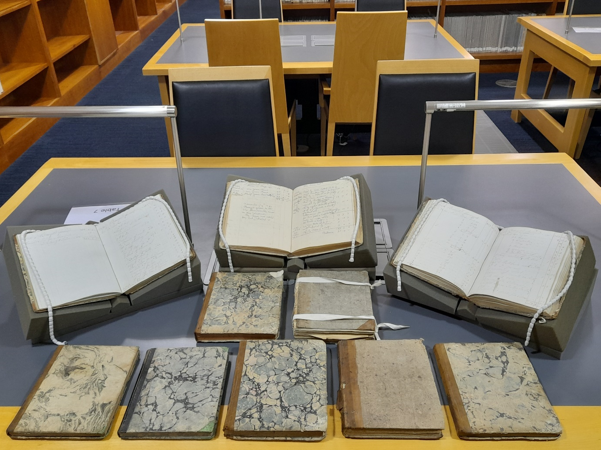MS 29 The Fownes/Tighe Manuscripts
The Fownes, the Tighes and Woodstock
The Fownes/Tighe manuscripts are a collection of handwritten estate papers dating from the 18th and early 19th century. The collection is named for the two families it concerns, the Fownes and the Tighes, who were connected by marriage and their association with Woodstock House and Estate in County Kilkenny. We have ten volumes of account books, the bulk of which concern Woodstock House and Estate in the period between 1790 and 1810 when it was owned by the Tighe family. There are eight volumes from this period which detail the sale and purchase of various crops, livestock and products as well as payments to workmen and other disbursements, and one volume which details the daily spending of the house between 1799 and 1806. The final volume in the collection is a rent book and dates from an earlier time than the rest of the collection. It details tenancy agreements and rent received from a number of properties owned by the Fownes family in Ireland and one property in Wales between 1731 and 1747.
Both the Fownes and Tighes were wealthy and influential families. As well as being large landholders they were political magnates; between 1650 and 1800 a member of every generation of the Fownes or Tighe families sat in the Parliament of Ireland. Sir William Fownes was a wealthy tea importer and blender, and served as Lord Mayor of Dublin between 1708 and 1709 and MP for Wicklow Borough in the Irish House of Commons from 1704 to 1713. The Fownes baronetcy was created in 1724 making him Sir William Fownes, 1st Baronet, a title which would be inherited by his grandson and namesake, William.
In 1725, while still a minor, his aforementioned grandson William Fownes inherited a large estate near Inistioge, County Kilkenny from his grandfather on his mothers’ side, William Sweete. In his adulthood Sir William Fownes, now the 2nd Baronet, would go on to marry Lady Elizabeth Ponsonby in 1739. The £4000 dowry he received would help finance the construction of a new residence on the estate in the 1740s, designed by the architect Francis Bindon; Woodstock House. The Tighe families association with Woodstock began when the only child of William and Elizabeth Fownes, Sarah, married William Tighe of Rossana, a large estate in County Wicklow. Sarah would pass the estate on to her son, also named William Tighe, in the 1790s.
The rent book gives us some idea of the extent of the land owned by the Fownes family in the 1730s and 40s, with records of properties across Kilkenny, Wicklow, Dublin, Offaly (known at the time as the King’s County) and Denbighshire in Wales. Below are the details of rent paid by Ann Burton for a house on College Green, on the west side of Fownes Court, for which she paid £10 per annum. Fownes Court was a property owned by the family near College Green. While it’s no longer there, the nearby Fownes Street still bears the family name. This example is representative of the contents of the ledger as a whole, handwritten records of tenants and their yearly rent payments; much less formal than a tenancy agreement today. The Mr. Cooke mentioned is the young William Fownes’ stepfather, who managed the estate until the youth reached his majority.

The Tighe era at Woodstock began with the death of Sir William Fownes in 1778 and his wife Elizabeth less than a month later, meaning that Woodstock Estate passed to his daughter Sarah Tighe. There was an allowance in the will for Sarah to pass the estate on to her son William in her lifetime if she did not wish to live in it, which she duly did in 1791- her name appears only in the account book from 1790.
The bulk of the Fownes/Tighe manuscripts concern Woodstock House and Estate in this period, between 1790 and 1810 when, barring 1790, the estate was owned by William Tighe. There are 8 volumes detailing the sale and purchase of various crops, livestock and products as well as payments to workmen. For instance the ledger from the year 1804 details weekly disbursements on the estate- including pay for workers and tradesmen- as well as money spent or received on the purchase or sale of wheat, oats, beer, sheep, wool, horned cattle, lambs, pigs, malt, hops, tallow and barley. There is also one ‘house book’ which details the expenditures of Woodstock House between 1799 and 1806. Here we have records of pay for servants, bills for tradespeople like bakers, money expended on groceries like fish, eggs, butter and beer and more. These ledgers provide an interesting insight into what life was like in one of Ireland’s ‘Big Houses’ at the start of the 19th century.


Woodstock House was burnt in 1922 in the aftermath of the Irish War of Independence, and now stands derelict. Its grounds are now owned by Kilkenny County Council and are a popular visitor attraction. What remains of the estates heyday are manuscripts like these. These kind of sources can provide historians with valuable insights. They can speak to how land was used and other trends in agriculture, how labour was compensated, landlord-tenant relationships, the workings of the economy and more. What might initially seem like dry paperwork contains a lot of information about the Ireland in the 18th and early 19th centuries, and tells us a lot about the wealth and status of these two influential families.

The Fownes/Tighe collection was donated to the University by the late Irish historian and former QUB faculty member J.C. Beckett, and is currently available for consultation in Special Collections and Archives in the McClay Library. You can view the collection listing here.
Andrew Harrison, Special Collections and Archives

